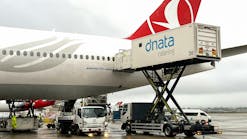Communication’s Critical Function in Catering
While there are many commonalities with mainline ground handing, the catering business has some peculiarities as a ground handling service, including the need to establish communications channels between the airline, the mainline ground handling company and the caterer, as well as the need to respond to the evolving needs of airlines.
Service Features
Inflight catering is an important part of the aviation supply chain and of the airline customer experience.
This is why Western Sydney International Airport (WSI) has recently released a request for proposal (RFP) for an inflight catering facility. In addition to ground handling expertise, WSI is seeking a partner with culinary expertise and the highest levels of food safety standards to deliver to domestic and international airlines departing from WSI as of 2026.
The peculiarities of catering as a ground handling service compared to mainline ground handling, depend on the individual airline requirements which are defined by their customer proposition and operational requirements, affirms Nerissa Moore, Oceania head of human resources at Gategourmet, a gategroup member.
“Factors that would be considered are the ability to produce quality and and quantity of meals, the ability to deliver the meals as per network needs, as well as quality assurance and safety capabilities and costs,” she says.
According to Robin Padgett, divisional senior vice president for catering and retail at dnata, catering operations have many similarities to the ramp operations of ground handling.
“There is the same care and attention, but where we do diverge is on the need to provide a controlled cool chain process throughout the transportation and loading of aircraft,” he says. “The industry has strict rules in place to ensure we always deliver a safe temperature-controlled product to our customers. This means providing systems and vehicles capable of keeping products chilled.”
According to Moore, the communication between the ground handling company and the catering company is focused mainly on day of operations items, points out.
“However, between the airline and the catering company there are daily communications from day of operations events through to forward planning of future of menus which is often driven by the season, the review of service level agreements (SLA), and the investigation of any operational disruptions or incidents,” she affirms.
Like in ground handling, good communications with the airline customers are vital, points out Padgett.
“In large hub operations, the catering is often embedded into the airlines’ operations centers to support rapid decision making; at smaller stations, instead, there are direct communication channels with the airlines’ station staff or their chosen representatives,” he says.
Evolving Needs
The needs of airlines have evolved over the years, and, in parallel, inflight catering has continued to be used to deliver a unique service proposition for airline customers and travelers.
In the rapidly changing landscape both parties need to be increasingly more agile to respond, observes Moore.
“Strong and effective communication within the partnership is essential from defining what the product offering is for the airline guests, for example whether it is free on board or a retail offering, right through from production to the day of operations events,” she says. “The benefit of being part of the largest global aviation caterer is our ability to leverage our experience, service our customers portfolio with our extensive network and offer innovative culinary excellence from our global team chefs. This combined with our full lounge, retail onboard and executive charter portfolio means we are fully equipped to meet the rapidly evolving needs of the aviation industry.”
According to Padgett, the way airlines have evolved over the past few years shows some significant trends.
“Firstly, airlines are developing their on-board service, this is because they want to differentiate themselves from their competitors. This has often been done by localizing elements of their product,” he affirms. “In some cases, there has been a strong push to increase the culinary component of their offering, and this has required investment in high quality, experienced chefs.”
Another major trend has been the increasing use of buy-on-board programs, observes Padgett.
“This has allowed for better customer choice and the opportunity for airlines to drive ancillary revenue. This requires a mastery of disciplines such as product sourcing, ranging, merchandising, data analytics, technology and supply chain management. dnata is one of the rare organizations to have this full suite of skills and we have been developing this part of our business for a number of years,” he concludes.





